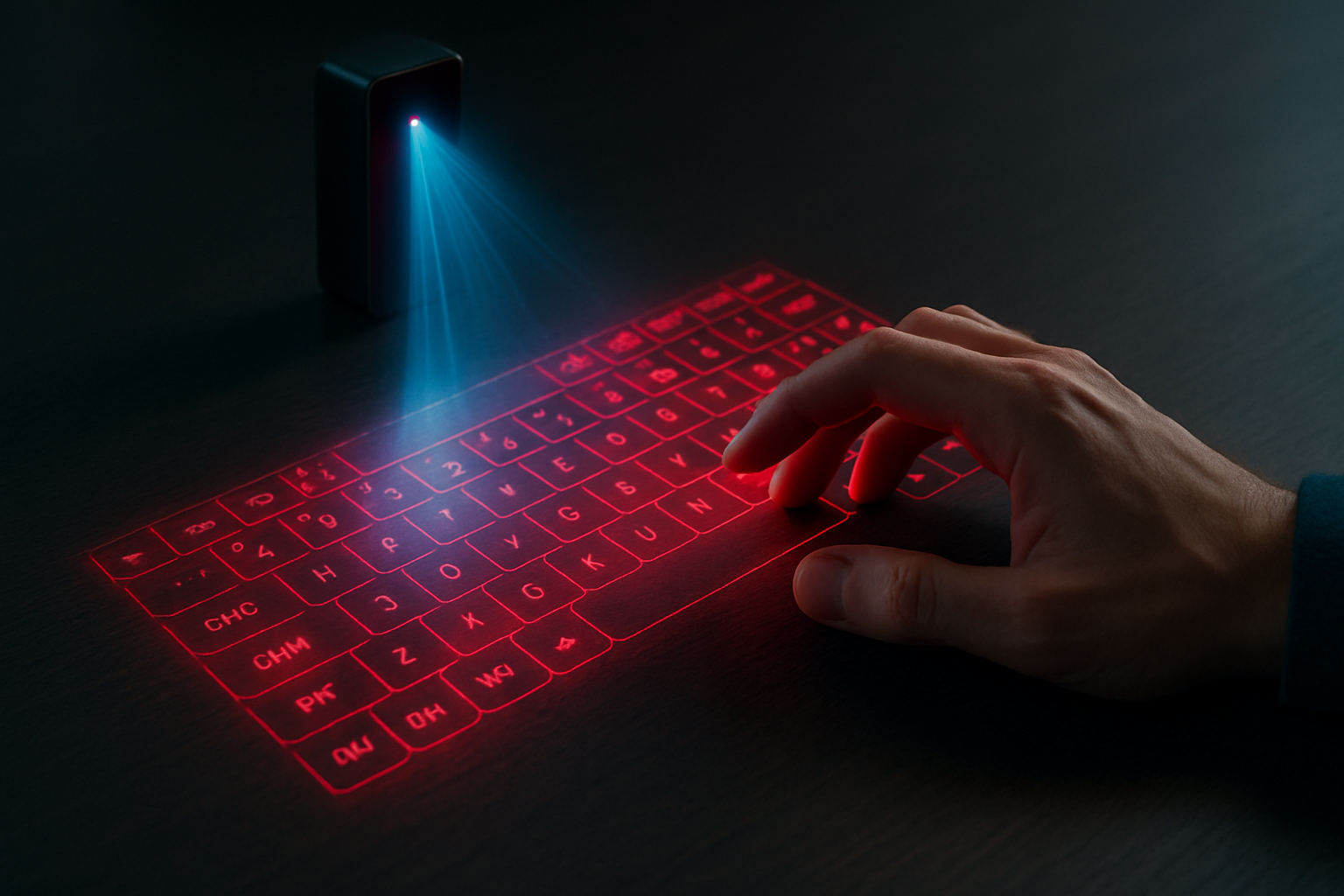Holographic Keyboards: Typing in Thin Air
In a world where technology continues to push the boundaries of what's possible, holographic keyboards are emerging as a futuristic input method that could revolutionize how we interact with our devices. These ethereal interfaces project a virtual keyboard onto any flat surface, allowing users to type without physical keys. As we delve into this cutting-edge technology, we'll explore its potential to reshape our digital interactions and the challenges it faces in becoming a mainstream input solution.

The Science Behind the Illusion
Holographic keyboards rely on a clever combination of optics and sensor technology to create the illusion of a physical keyboard. At their core, these systems use a laser projector to display a keyboard image on a flat surface. This projection is typically accomplished through a diffractive optical element (DOE), which splits the laser beam into the desired pattern.
Alongside the projection system, an infrared light plane hovers just above the surface. When a user’s fingers break this plane, cameras or sensors detect the interruption and interpret it as a keystroke. Advanced algorithms then translate these detected movements into text input, mimicking the functionality of a traditional keyboard.
A Brief History of Virtual Keys
The concept of holographic keyboards isn’t entirely new. Early patents for similar technologies date back to the early 2000s, with companies like VKB (Virtual Keyboard) and Celluon pioneering some of the first commercial prototypes. These initial offerings were bulky, expensive, and often unreliable, relegating them to the realm of tech curiosities rather than practical input devices.
However, as projection technology improved and sensors became more sophisticated, holographic keyboards began to evolve. By the mid-2010s, more compact and user-friendly versions started to appear, sparking renewed interest in the technology’s potential.
Current State of the Art
Today’s holographic keyboards have come a long way from their clunky predecessors. Modern iterations boast improved accuracy, lower latency, and more compact form factors. Some models, like those developed by Serafim Technologies, can even project onto curved surfaces, expanding their versatility.
These advancements have led to increased adoption in niche markets. For example, some hospitals have begun using holographic keyboards in sterile environments where traditional keyboards would be difficult to sanitize. Similarly, they’ve found a place in industrial settings where physical keyboards might be prone to damage from dust or debris.
The Pros and Cons of Typing on Light
Like any emerging technology, holographic keyboards come with their own set of advantages and drawbacks. On the plus side, they offer unparalleled portability. A single, compact projector can replace a full-sized keyboard, making them ideal for mobile professionals or those with limited desk space.
Additionally, their lack of physical components means they’re inherently waterproof and dustproof, potentially increasing their longevity in harsh environments. The ability to customize the keyboard layout on the fly is another significant advantage, allowing users to switch between different languages or specialized layouts with ease.
However, the technology isn’t without its challenges. The lack of tactile feedback can be disorienting for touch typists accustomed to physical keys. While some manufacturers have experimented with haptic feedback systems to simulate key presses, these solutions are still in their infancy.
Accuracy and responsiveness remain ongoing concerns. Even the most advanced holographic keyboards can struggle in less-than-ideal lighting conditions or on uneven surfaces. And while latency has improved, it still lags behind traditional keyboards, potentially frustrating fast typists.
The Future of Holographic Input
As holographic keyboard technology continues to evolve, we’re likely to see improvements that address many of its current limitations. Research into advanced sensor technologies and machine learning algorithms could lead to more accurate and responsive systems. Integration with augmented reality (AR) platforms might also open up new possibilities, allowing for truly three-dimensional interfaces that extend beyond flat surfaces.
Some experts envision a future where holographic keyboards are just one part of a larger ecosystem of projected interfaces. Imagine a workspace where your entire desk becomes an interactive surface, with keyboards, touchpads, and other controls materializing whenever and wherever you need them.
Market Impact and Price Points
The holographic keyboard market, while still relatively small, is growing steadily. Market research firm MarketsandMarkets projects that the global holographic display market, which includes holographic keyboards, will reach $3.57 billion by 2025, growing at a CAGR of 30.8% from 2020 to 2025.
Current consumer-grade holographic keyboard projectors typically range from $100 to $300, positioning them as premium peripherals. However, as the technology matures and production scales up, we can expect these prices to decrease, potentially bringing holographic keyboards into the mainstream.
Challenges on the Horizon
Despite their potential, holographic keyboards face several hurdles on their path to widespread adoption. Battery life remains a concern for portable projectors, limiting their usefulness for all-day typing sessions. Additionally, the technology needs to prove its long-term reliability and durability to compete with traditional keyboards in professional settings.
Perhaps the biggest challenge is simply overcoming user habits. Keyboards have been a staple of computing for decades, and convincing users to abandon the familiar feel of physical keys for a projected alternative is no small task. It will likely take time and continued refinement before holographic keyboards can truly challenge their physical counterparts in the mass market.
As we look to the future of human-computer interaction, holographic keyboards represent an intriguing possibility. While they may not be ready to replace traditional keyboards just yet, their potential for creating flexible, customizable, and space-efficient input solutions is undeniable. As the technology continues to evolve, we may find ourselves increasingly typing on beams of light, bringing a touch of science fiction to our everyday computing experiences.





